Calle Real, Iloilo
- De la Rama Street
- Ortiz Street
- Macario Peralta Street
- Mapa Street
- Aduana Street
- Guanco Street
- Aldeguer Street
- Arsenal Street
- Arroyo Street
Calle Real (transl. Royal Street), officially named as J.M. Basa Street, is a historic street located in the old downtown district Iloilo City Proper of Iloilo City, Philippines. The street often referred to as the "Escolta of Iloilo", and is also one of the country’s oldest business districts.[1] It is home to several fine examples of historic luxury American era neoclassical, beaux-arts, and art deco buildings. The street has been famous since the Spanish Era. However, its importance has dwindled and the street has become less maintained; yet there have been efforts to revitalize the street, which include the restoration of the historic buildings along the street and beautification projects.
The street's heritage designation by the local government, has been expanded into a zone known as Calle Real Heritage Zone which covers the long stretch of J.M. Basa and the streets and thoroughfares of Aldeguer, Mapa, Ortiz, Muelle Loney (Loney Wharf), Solis, Rizal, Iznart (from Chinese Arch to Iloilo Central Market).
History

Even during the Spanish colonial era, Calle Real was the main street of commerce for Iloilo. José Rizal was even impressed by the city during his arrival.[2]
During the early period of American occupation of the Philippines, Calle Real was known as a hub of high-end shopping outlets selling products from Europe.[3][4]
The street was officially renamed in honor of Jose Maria Basa, a Filipino businessman-propagandist who was a compatriot of José Rizal.[1] The street remained popularly known as Calle Real. The name would also be later used to refer to the central business district of Iloilo City.[5]
The Art-Deco buildings and other structures along the street deteriorated but remained to be a shopping hub of the city. Calle Real as a district consisting of Aldeguer, Guanco and Iznart, J. M. Basa, and Mapa streets was declared an Iloilo City heritage zone by the virtue of Ordinance No. 00-054, also known as the Local Cultural Heritage Conservation Ordinance which established the Iloilo City Cultural Heritage Conservation Council (ICCHC).[5]

The National Historical Commission of the Philippines declared Calle Real as a district and a heritage zone on August 8, 2014, with the unveiling of a historical marker outside the Villanueva Building.[4] Its current restoration has been a public-private partnership between the government and the Iloilo Cultural Heritage Foundation, Inc. (ICHFI).
Other efforts to revitalize the district include the pedestrianization of Calle Real, burying of utility wires, and minimizing obstructive advertisements. Regarding pedestrianization, experimentations have been done, including closing the road during Sundays, but permanent pedestrianization is still contested.[6] Cultural performances are staged to promote Ilonggo heritage and to attract domestic and foreign tourists.[4] The experimentation ended on March 9, 2014; the Philippine Chamber of Commerce Iloilo wished to make this permanent, citing this opportunity to make walking viable and to take pride in the newly rehabilitated heritage buildings of the street.[7]
Notable structures

Calle Real is noted for its historic buildings and structures, many of which were built between the late 19th century and the early 20th century.[4]
- Eusebio Villanueva Building – Formerly known as the Washington International Hotel, this building dates back to 1927. It hosted American, British, and Spanish patrons as well as Chinese bankers and merchants. It fell into disuse and deteriorated but was restored in 2012.[3]
- Javellana Building – Built in 1922, this neo-Renaissance architectural building now houses a tenant for Sarabia Optical.
- Celso Ledesma Building – Constructed in 1923, this commercial building now houses several well-known local stores.
- Regent Building – Built in 1928, it housed one of the first movie theatres in the country to operate for a long time, Cine Palace. Though its interior was renovated in the early 1980s or late 1970s, it retained its façade in the Neo-Classical style.
- Cine Eagle – Constructed in 1927, it became one of the largest and most modern theaters in the country at the time.
- Lux Theater – Another theater, opened on May 7, 1922, by Don Julio Q. Javellana and William Henry Horstmann.
- Aduana de Iloilo – Also known as the Iloilo Customs House, located on the Sunburst Park. It is the largest customs house outside Manila and one of only three heritage customs houses in the country, alongside those in Manila and Cebu.
- Elizalde Building – This bahay na bato--styled edifice now houses the Philippine Museum of Economic History, the first museum dedicated to economic history in the Philippines.
- Hoskyn's Department Store – Established in 1877, it is the first and oldest existing department store in the Philippines.[8]
- Iloilo Masonic Temple – facing Plaza Libertad, was completed in 1928. It serves as the headquarters of Iloilo-Acacia Lodge No. 11, which was chartered on February 13, 1917. During World War II, it was used as the headquarters of the Japanese Imperial Army. It was declared a National Historical Landmark on February 9, 2018.[9][10]
- Plaza Libertad – a historic plaza where the flag of the first Philippine Republic was raised after Spain surrendered Iloilo.
Gallery
-
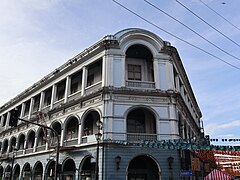 Eusebio Villanueva Building façade
Eusebio Villanueva Building façade - Eusebio Villanueva Building left side view
-
 Javellana Building
Javellana Building -
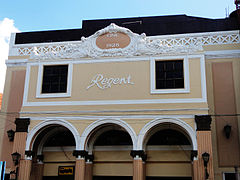 Regent Theater Building
Regent Theater Building -
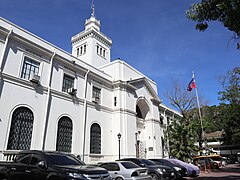 Iloilo Customs House, also known as Aduana de Iloilo
Iloilo Customs House, also known as Aduana de Iloilo -
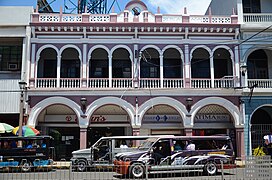 Divinagracia-Alba Building
Divinagracia-Alba Building - Serafin Villanueva Building
-
 Celso Ledesma Building
Celso Ledesma Building -
 Edificio Elizalde y Cia Building
Edificio Elizalde y Cia Building
See also
References
- ^ a b "Calle Real Seen as Business Zone". Iloilo Metropolitan Times. 15 August 2014. Archived from the original on 4 March 2016. Retrieved 15 January 2016.
- ^ Piccio, Belle (20 May 2014). "The Royal Street of Iloilo: Calle Real". Choose Philippines. Archived from the original on 4 March 2016. Retrieved 15 January 2016.
{{cite web}}: CS1 maint: unfit URL (link) - ^ a b Jardiolin, Victoria B. (19 November 2012). "Calle Real, Iloilo City's Heritage Street, Restored". Inquirer.net. Archived from the original on 4 March 2016. Retrieved 15 January 2016.
- ^ a b c d Yap, Tara (11 August 2014). "Calle Real Embodies Iloilo's Glorious Past". Manila Bulletin. Archived from the original on 3 May 2022. Retrieved 15 January 2016.
- ^ a b "'Save Calle Real' Forum Set". The News Today Online Edition. 10 May 2006. Archived from the original on 24 May 2019. Retrieved 15 January 2016.
- ^ Pendon, Lydia C. (30 March 2014). "Calle Real Pedestrianization Program Hits Snag". The Manila Times. Archived from the original on 4 March 2016. Retrieved 15 January 2016.
- ^ Mateo, Wenceslao E. Jr. (9 April 2014). "Permanent Calle Real Pedestrianization Mulled". The Daily Guardian. Archived from the original on 4 March 2016. Retrieved 15 January 2016.
- ^ "Consumer goods sold in Iloilo City, 1930s". www.thenewstoday.info. Retrieved 28 May 2023.
- ^ "The Iloilo Masonic Temple". Fratshirt Clothing. Retrieved 8 July 2024.
- ^ Cajilig-Luján, Nereo, The Iloilo Masonic Temple, Province of Iloilo
External links
 Media related to J.M. Basa Street (Iloilo City) at Wikimedia Commons
Media related to J.M. Basa Street (Iloilo City) at Wikimedia Commons
- v
- t
- e
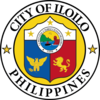
- Arroyo Fountain
- Calle Real
- Camiña Balay Nga Bato
- Casa Mariquit
- Casa Real de Iloilo
- CPU Church
- Iloilo Business Park
- Iloilo Convention Center
- Iloilo Customs House
- Iloilo Museum of Contemporary Art
- Iloilo River Esplanade
- Jaro Belfry
- Jaro Cathedral
- Lopez Heritage House
- Molo Church
- Molo Mansion
- Museo Iloilo
- Old Iloilo City Hall
- Old Jaro Municipal Hall
- Plaza Libertad
- San Jose Church
- Primary and secondary schools
- Universities and colleges
- Western Visayas
- Philippines
 Category
Category























